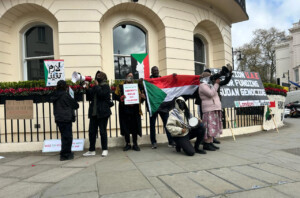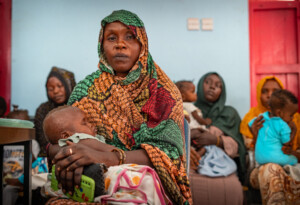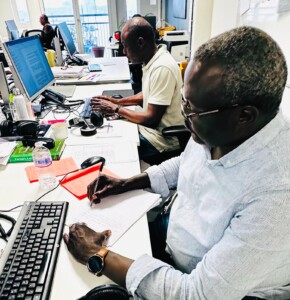Sudan OCHA bulletin 20: Thousands of displaced return to their homes in South Darfur’s Kass locality
About 10,000 internally displaced people (about 2,050 families) have spontaneously returned to their villages of origin (Kalu, Komba, Morotoga, Musobikira, Brunga El Fil, Dawis, Karende) in Kass locality, South Darfur, according to initial findings of an interagency mission carried out from 27 November to 3 December.

About 10,000 internally displaced people (about 2,050 families) have spontaneously returned to their villages of origin (Kalu, Komba, Morotoga, Musobikira, Brunga El Fil, Dawis, Karende) in Kass locality, South Darfur, according to initial findings of an interagency mission carried out from 27 November to 3 December.
According to the latest bulletin of the UN Office for the Coordination of Humanitarian Affairs (OCHA) in Sudan, the security was calm in all the villages reached and the returnees intend to stay permanently, the mission found. The returnees had fled their homes between 2004 and 2005 following the eruption of conflict in Darfur and took refuge in internally displaced persons (IDP) camps in Kass locality.
Sheikhs (community leaders) reported that a further 1,373 families (about 7,000 people) had voluntarily returned to villages nearby. An additional 65 families (about 300 people) have seasonally returned to Warow village in the area. The houses in Warow were built with local materials (temporary) and most of them were unoccupied as their owners had yet to return for farming.
Recommendation by the assessment team include for the International Organization for Migration (IOM) to register the returnees (to determine the amount humanitarian supplies needed); providing basic services such as health, water, sanitation and hygiene, education, food, livelihood assistance and security; training and capacity-building for members of the peace-coexistence committee and the native administrative, including local authorities; regular patrols by security forces to protect crops and support the peace coexistence committee tackle cases of agricultural land disputes; and establishing peace coexistence committees in return villages where they do not exist.
The mission was comprised of representatives from the Government’s Voluntary Return and Resettlement Commission (VRRC), the Humanitarian Aid Commission (HAC), the International Organization for Migration (IOM), the UN Refugee Agency (UNHCR) and two community leaders.
South Sudanese refugee figure revised up to 851,313 following updated population statistics
The total number of South Sudanese refugees in Sudan as of end of November 2018 stands at 851,313, according to UNHCR. This figure was revised to include additional people registered by the Immigration and Passport Police (IPP) in Gedaref, El Gezira, River Nile and Northern states, as well as additional estimates from inter-agency out-of-camp assessments carried out in White Nile State.
In addition to the 371,591 refugees who were officially registered by UNHCR and COR, the revised total figure includes 355,434 South Sudanese refugees registered through the ongoing IPP process, as well as approximately 112,000 people identified mainly in out-of-camp locations who have not yet been registered by IPP or by UNHCR and COR. The IPP started the process of recording South Sudanese refugees in April 2018 in order to provide them with foreigner identification numbers and refugee ID cards.
As of end November 2018, 45 per cent of reported South Sudanese refugees have been registered by UNHCR and COR, which is usually a prerequisite for accessing refugee assistance services. There are plans to accelerate the UNHCR and COR registration process in 2019 to ensure that refugees have access to protection—including documentation—as well as other basic services and material assistance needed.
Scale up of health and hygiene assistance in South Kordofan
Save the Children International (SCI) began the construction of a new health centre in Qurayd in Abu Jubeiha locality (South Kordofan), which will provide primary health care services for over 5,000 refugees and people from the host community.
In El Leri locality, UNHCR provided a two-month supply of medicine to the health centre at Dar Batti settlement to support the health needs of over 6,000 refugees and people from the host community who regularly access the centre. In addition, Care International Switzerland (CIS) is supporting the scale up of hygiene interventions for refugees in the locality, including the distribution of a three-month supply of soap for over 9,600 refugees. CIS also distributed personal hygiene kits (PHKs)—enough to cover three months—to over 2,700 refugee women and girls in the area. An additional 4,000 PHK kits will be distributed to refugee women and girls in El Leri throughout 2019.
Improving access to water for refugees in Beliel camp in South Darfur
Norwegian Church Aid (NCA) has completed the construction of a new water yard for the refugee settlement at Beilel IDP camp where 4,560 South Sudanese refugees are currently living, improving refugees’ access to safe water from 7 litres per person per day to 11 litres. NCA has also begun the construction of an additional water yard with the aim to increase water access to 20 litres per person per day. Both refugees and IDPs will have access to the water yards.
Clean water is now a short walk away for 40,000 people
An estimated 40,000 residents, IDPs and nomads in Central Darfur’s Mukjar locality now have better access to clean water following the repair of 31 hand pumps that had broken down and been left unused for the past few years, reports the International Committee of the Red Cross (ICRC). ICRC staff and volunteers of the Sudanese Red Crescent Society (SRCS) carried out the repair of these hand pumps in Mukjar town, Brindisi and surrounding villages.
One of the people who can now obtain water from these hand pumps is Sheikh Mohammed Abdeljabar. Sheikh Abdeljabar was displaced from his home in Zoowa in 2007 and has been taking refuge in Mukjar ever since. As a person with a physical disability has found it difficult to undertake the four-hour journey to and from the closest water source. At times, he spent up to one week without water.
"My neighbour, he has a donkey and so he was always able to go and fetch water from there. He was always gracious enough to give me one jerry can of water per week," said Abdeljabar.
One of the hand pumps repaired by the ICRC-SRCS teams was located just 50 meters from Abdeljabar's residence and now he can easily get all the water he needs.
Cash shortages are affecting humanitarian operations across the country
The shortage of local currency at banks is affecting humanitarian operations across the country. Most local banks have a limit on withdrawals, while automated teller machines (ATMs) have a withdrawal ceiling of 2,000 Sudanese pounds (about US$42) per day. In addition, local vendors in some states are reluctant to provide supplies to humanitarian organizations as local banks have insufficient funds to pay for them. The reluctance of vendors to provide goods and services has affected procurement and has a direct impact on beneficiaries when partners are unable to procure aid supplies from local markets. Efforts are underway to find solutions for cash shortages allowing organizations to effectively assist those in need.
Despite average harvest, food insecurity persists – FEWS NET
As Sudan continues to face economic challenges and a shortage of hard currency, food prices have risen 150 to 200 per cent above average in December and are expected to further increase to 200 to 250 per cent during the 2019 lean season. This increase in prices will likely reduce household access to food, says FEWS NET in its latest report.
Rainfall from June to September was well above average and supported favourable crop yields across the country. This type of rainfall performance would typically lead to an above-average harvest, however, economic challenges over the past year have negatively impacted both the planting and harvesting of crops, says FEWS NET. During the November 2018 to February 2019 harvesting period, people’s access to food will be less than in normal years, as many poor households obtain a portion of their food needs from market purchases even during the harvest. However, with below-average purchasing power, they will face difficulty purchasing normal levels of food and non-food supplies, reports FEWS NET.
Between March and May 2019, food security will deteriorate as poor households begin to deplete household food stocks and become even more dependent on markets. Many areas will be at Stressed – equivalent to the Integrated Food Security Phase Classification (IPC) Phase 2 – levels of food insecurity, while much of North Darfur, Jebel Marra, Red Sea, and parts of West Kordofan, North Kordofan, South Kordofan, Blue Nile, Kassala, will be in Crisis (equivalent to IPC Phase 3) levels, says FEWS NET.
Khartoum declaration on cross-border health security
In late November, Chad, Egypt, Ethiopia, Libya, South Sudan and Sudan signed the Khartoum Declaration on Sudan and Bordering Countries: Cross-Border Health Security in Khartoum, Sudan. The declaration commits to strengthening preparedness and response to public health threats and events across borders in efforts to further the implementation of the International Health Regulations (IHR 2005) and enhance global health security. As part of the Khartoum Declaration, countries pledged to establish a public health cross-border coordination centre to facilitate cross-border collaboration, develop a memorandum of understanding and implement activities to strengthen public health preparedness and response across borders. They also pledged to develop a monitoring and evaluation framework to track progress and to mobilize human, financial and logistical resources.
“Health security and addressing public health threats are the responsibility of all and require the cooperation of individuals, communities, and institutions. WHO is supporting a coordinated and combined response that ensures all at-risk countries are able to prepare and respond to all threats, and that contributions to peace are made through health,” said Dr Naeema Al Gasseer, WHO Representative in Sudan.
Common challenges that contribute to the risk of diseases crossing borders, including unofficial ground crossings and porous borders, are high levels of mass displacement and irregular patterns of migration, poor infrastructure at borders, and limited joint activities related to surveillance, information-sharing, risk assessment and response across borders.
Through the implementation of technical frameworks for bilateral and multilateral collaboration over the next two years, countries will be able to successfully address and strengthen areas of mutual concern that make them vulnerable to public health threats, thereby increasing health security for millions of vulnerable people.











 and then
and then